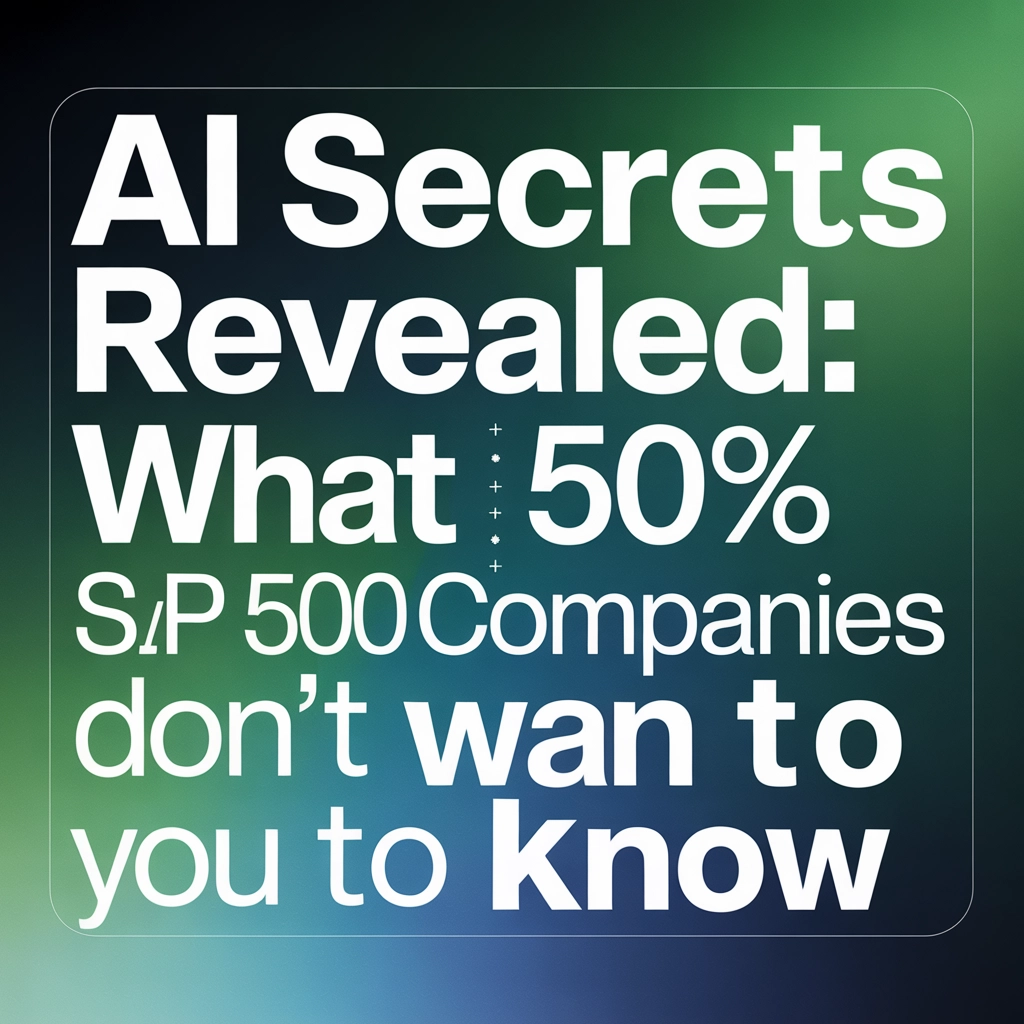What if I told you the biggest "secret" about AI in corporate America isn't actually a secret at all?
While conspiracy theorists love to imagine boardrooms plotting to hide AI's dark truth, the reality is far more interesting. S&P 500 companies aren't concealing their AI strategies, they're being surprisingly honest about them. And what they're revealing might shock you more than any hidden agenda.
The Trillion-Dollar Reality Check
Here's what Wall Street doesn't want splashed across every headline: Morgan Stanley's analysts project that AI could generate $920 billion in net annual benefits for S&P 500 companies. That's roughly 28% of the entire index's projected earnings for 2026.
But here's the kicker, these same analysts are openly saying this transformation will "likely take many years to achieve" and carries "significant risk" that companies might not reach full adoption levels.

Think about it. If you were a CEO sitting on a technology that could potentially cut your costs by hundreds of billions, wouldn't you be shouting it from the rooftops? Instead, these companies are practically whispering warnings about implementation challenges and uncertain returns.
The projected savings would come primarily from reduced payroll expenses as AI takes over repetitive tasks. We're talking about 90% of jobs being touched by AI automation in some form. That's not a secret conspiracy, that's a publicly disclosed workforce transformation that's happening whether we acknowledge it or not.
Risk Disclosures Are Actually Increasing
Remember when tech companies used to promise the moon without mentioning the crater-sized risks? Those days are over.
76% of S&P 500 firms now cite AI as a material risk in their official disclosures. Let that sink in. Three-quarters of America's biggest companies are voluntarily telling investors, "Hey, this AI thing might not work out the way we hope."

This represents a massive shift in corporate transparency. Just a year ago, most companies treated AI purely as a strategic advantage. Now they're openly discussing it as a systemic risk requiring careful management.
Among the companies brave enough to get specific, 57 firms acknowledged that AI may not deliver expected ROI or operational benefits. These aren't small-cap startups making wild promises: these are Fortune 500 giants admitting they might be wrong about their billion-dollar AI bets.
Sarah, a compliance officer at a major tech firm, told me last month: "We used to get pushback when we wanted to include AI risks in our 10-K filings. Now the board is asking us if we're being transparent enough about potential downsides."
Board Oversight Isn't Secret Anymore
Corporate governance around AI is becoming surprisingly robust. 31% of S&P 500 companies disclosed some level of board oversight of AI in 2024. That's an 84% increase from the previous year and over 150% growth since 2022.
These aren't token committees created for show. We're talking about:
• Specific AI oversight committees with defined responsibilities
• Directors hired specifically for their AI expertise
• AI ethics boards with real decision-making power
• Regular board reporting on AI implementation risks
• Formal policies governing AI deployment across operations
The Information Technology sector leads with 51% of companies reporting AI oversight measures, followed by Communications at 37%. This widespread adoption of formal oversight structures shows companies are actively managing AI governance rather than hoping for the best.

What's fascinating is that companies aren't required to disclose this level of AI oversight. They're choosing to be transparent about their governance structures, which suggests they view accountability as a competitive advantage rather than regulatory burden.
The Real Numbers Behind AI Hype
Here's where things get really interesting. Despite all the AI buzz, only 8% of the S&P 500's total weight is actually tied to AI-related product lines. NVIDIA and Alphabet represent the largest sources of exposure, but even then, we're talking about a surprisingly small slice of the overall market.
Just 16 companies currently report AI-attributed revenue. Another 25 have AI initiatives without measurable revenue: often representing research and development efforts that may or may not pay off.

Even more surprising? AI adoption rates are declining among companies with more than 250 employees. While small startups are racing to implement AI solutions, larger organizations are pumping the brakes. They're dealing with complex legacy systems, regulatory requirements, and integration challenges that make AI deployment far more complicated than Silicon Valley suggests.
This creates an interesting paradox. The companies with the most resources to implement AI effectively are also the most cautious about rushing into deployment. Meanwhile, the companies most likely to benefit from AI automation: those with large operational workforces: are taking the most measured approach.
The pattern suggests that successful AI implementation isn't about having the best technology or the biggest budget. It's about having the patience and infrastructure to integrate AI thoughtfully rather than reactively.
What This Really Means
The most revealing aspect of AI adoption among S&P 500 companies isn't what they're hiding: it's their increasing willingness to discuss both opportunities and obstacles openly.
Companies are voluntarily disclosing implementation challenges, potential workforce impacts, governance frameworks, and the very real possibility that their AI investments might not deliver expected returns. This level of transparency represents corporate maturity rather than secretiveness.
Instead of hiding AI secrets, these companies are demonstrating something far more valuable: honest assessment of transformative technology. They're acknowledging that AI represents both tremendous opportunity and significant risk, requiring careful management and realistic expectations.
So what do you think: are we better off with companies that overpromise AI benefits, or ones that honestly discuss both the potential and the pitfalls?







